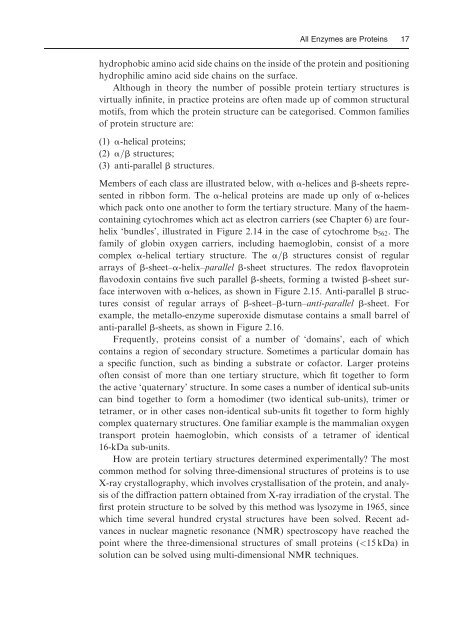Introduction to Enzyme and Coenzyme Chemistry - E-Library Home
Introduction to Enzyme and Coenzyme Chemistry - E-Library Home
Introduction to Enzyme and Coenzyme Chemistry - E-Library Home
Create successful ePaper yourself
Turn your PDF publications into a flip-book with our unique Google optimized e-Paper software.
All <strong>Enzyme</strong>s are Proteins 17<br />
hydrophobic amino acid side chains on the inside of the protein <strong>and</strong> positioning<br />
hydrophilic amino acid side chains on the surface.<br />
Although in theory the number of possible protein tertiary structures is<br />
virtually inWnite, in practice proteins are often made up of common structural<br />
motifs, from which the protein structure can be categorised. Common families<br />
of protein structure are:<br />
(1) a-helical proteins;<br />
(2) a=b structures;<br />
(3) anti-parallel b structures.<br />
Members of each class are illustrated below, with a-helices <strong>and</strong> b-sheets represented<br />
in ribbon form. The a-helical proteins are made up only of a-helices<br />
which pack on<strong>to</strong> one another <strong>to</strong> form the tertiary structure. Many of the haemcontaining<br />
cy<strong>to</strong>chromes which act as electron carriers (see Chapter 6) are fourhelix<br />
‘bundles’, illustrated in Figure 2.14 in the case of cy<strong>to</strong>chrome b 562 . The<br />
family of globin oxygen carriers, including haemoglobin, consist of a more<br />
complex a-helical tertiary structure. The a=b structures consist of regular<br />
arrays of b-sheet–a-helix–parallel b-sheet structures. The redox Xavoprotein<br />
Xavodoxin contains Wve such parallel b-sheets, forming a twisted b-sheet surface<br />
interwoven with a-helices, as shown in Figure 2.15. Anti-parallel b structures<br />
consist of regular arrays of b-sheet–b-turn–anti-parallel b-sheet. For<br />
example, the metallo-enzyme superoxide dismutase contains a small barrel of<br />
anti-parallel b-sheets, as shown in Figure 2.16.<br />
Frequently, proteins consist of a number of ‘domains’, each of which<br />
contains a region of secondary structure. Sometimes a particular domain has<br />
a speciWc function, such as binding a substrate or cofac<strong>to</strong>r. Larger proteins<br />
often consist of more than one tertiary structure, which Wt <strong>to</strong>gether <strong>to</strong> form<br />
the active ‘quaternary’ structure. In some cases a number of identical sub-units<br />
can bind <strong>to</strong>gether <strong>to</strong> form a homodimer (two identical sub-units), trimer or<br />
tetramer, or in other cases non-identical sub-units Wt <strong>to</strong>gether <strong>to</strong> form highly<br />
complex quaternary structures. One familiar example is the mammalian oxygen<br />
transport protein haemoglobin, which consists of a tetramer of identical<br />
16-kDa sub-units.<br />
How are protein tertiary structures determined experimentally The most<br />
common method for solving three-dimensional structures of proteins is <strong>to</strong> use<br />
X-ray crystallography, which involves crystallisation of the protein, <strong>and</strong> analysis<br />
of the diVraction pattern obtained from X-ray irradiation of the crystal. The<br />
Wrst protein structure <strong>to</strong> be solved by this method was lysozyme in 1965, since<br />
which time several hundred crystal structures have been solved. Recent advances<br />
in nuclear magnetic resonance (NMR) spectroscopy have reached the<br />
point where the three-dimensional structures of small proteins (



